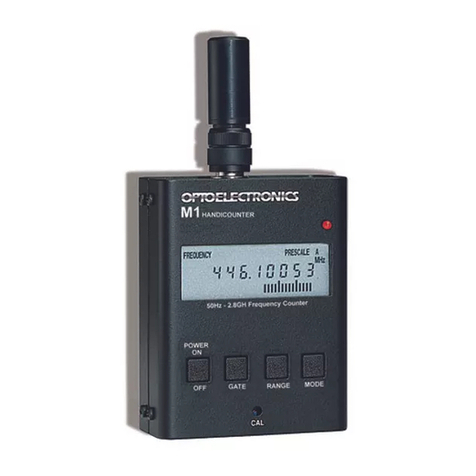Optoelectronics Spectrum Scout User manual

160 West Camino Real #233
Boca Raton, FL 33432
Telephone: 954-642-8997
Fax: 954636-3533
www.optoelectronics.com
Copyright 2008©
®
OPTOELECTRONICS

Spectrum Scout
USER MANUAL

Table of Contents
ntroduction 1
Front Panel 2
Top Panel 3
Getting Started 4
Function Button 5-8
Reaction Tune 9-10
Memory Download and Datalogging 11
Upload a Database 12
Specifications 13
What to Expect 14
Antennas and Accessory Recommendations 15
Factory Service/Warranty 16
Optoelectronics, COM, AOR, Microsoft are registered trademarks.

16
PRODUCT WARRA TY
Optoelectronics, nc. warrants all products and accessories for one (1) year against defects in materi-
als and workmanship to the original purchaser. Products returned for warranty service will be
repaired or replaced at Optoelectronics’ option.
Specifically excluded are any products returned under this warranty that upon examination, have
been modified, had unauthorized repairs attempted, have suffered damage to the input circuitry from
the application of an excessive input signal, have suffered damage to the charging circuitry or inter-
nal batteries from the application of excessive voltage, or show other evidence of misuse or abuse.
Optoelectronics reserves sole right to make this determination.
O -WARRA TY
Products not under warranty must be returned, transportation prepaid, to Optoelectronics’ service
center. Factory service will be performed on a time and materials basis at the service rate in effect at
the time of repair. A repair estimate prior to commencement of service may be requested. Return
shipping will be added to the service invoice and is to be paid by the customer.
RETUR POLICY
Please contact us first for assistance and to obtain a return authorization number. Service
Department: (954) 642-8997. Monday - Friday 8:30 AM to 5:00 PM Eastern Time.
Warranty

15
Antenna and Accessory Recommendations
A TE AS
The small dual band VHF/UHF, DB32 antenna, is a very good multi-purpose antenna capable of pick-
ing up a wide range of frequencies from 100MHz to 2GHz. The BB85 VHF/UHF rubber duck anten-
na is also cable of picking up a wide range of frequencies from 100MHz to 2GHz. There are other
antennas available that are useful for specific frequency ranges.
RD27 26-150MHz
RD150 144-165MHz
RD440 440-480MHz
RD800 500MHz-1GHz
RD2400 2400MHz-2500MHz
TA100S 100MHz-600MHz
CELL LOCK 800MHz-2GHz
FILTERS
The N100 FM broadcast notch filter will remove the influence of local FM stations (88-108MHz), pro-
viding up to 30dB of attenuation.
SERIAL DATA I TERFACE
The Spectrum Scout incorporates an RS232 interface for the purpose of interfacing to a PC. The fre-
quencies saved to memory may be downloaded using the Spectrum Scout download program. The
Spectrum Scout may also log frequencies to the PC in real time using the Spectrum Scout datalogging
program. The CBDS interface cable and software are sold separately.

This manual covers connection and operating instructions for the
Optoelectronics Spectrum ScoutTM. The Optoelectronics Spectrum
ScoutTM is covered under U.S. Patent umber 5,471,402 and other
patents pending.
C
C
WAR I G - Maximum input voltage is 12VDC. Automotive voltages may exceed 12V caus-
ing damage to internal circuitry. Damage resulting from excessive input voltage is readily appar-
ent and will not be covered under warranty. Units returned for warranty service that have damage
resulting from excessive supply voltages will incur service charges.
WAR I G - Maximum antenna input signal is +15dBm (50mW). Under no circumstances
should the Spectrum Scout be directly connected to an RF transmitter or be used in close proxim-
ity to a radio transmitter of more than 5 watts. Damage to the input amplifier circuitry is readily
apparent and will not be covered under warranty. Units returned for warranty service that have
damage to the input circuitry will incur service charges.
CAUTION
!

ntroduction
1
How many times have you locked on to a frequency and wondered what that frequency was allocated
to in the FCC bandplan. You no longer have to wonder because the Spectrum Scout will identify that
frequency for you. The Spectrum Scout is the first nearfield device capable of displaying the FCC band-
plan information with each frequency captured. With a frequency range of 10MHz-2.6GHz, over 1000
FCC records are programmed into the Spectrum Scout. The Spectrum Scout is the latest advancement
in hand held test equipment by Optoelectronics, nc.
With over 1000 records programmed into the Spectrum Scout you can use the unit as your own portable
reference guide. Without having to lock on to a frequency just use the arrow buttons to move through
the database in steps of 1, 5, 6.25, 10, 12.5, 25, 30, and 50KHz steps. You may also move in steps of 1,
5, and 10MHz. This allows for easy lookup of the FCC bandplan information.
A great feature of the Spectrum Scout is its ability to allow the user to upload their own frequencies for
their specific location. Using simple text files and and an upload program that is supplied by
Optoelectronics, you can easily load your own information for specific frequencies. For instance, you
could name your local repeater that is operated by your amateur radio club, or identify your local munic-
ipality frequencies. There are many possibilities. f you don't live in the U.S. your allocation tables may
be much different and you can easily upload all of the information for your city or country.
The Spectrum Scout also incorporates the feature that was patented by Optoelectronics, nc., Reaction
Tune. This unique feature allows the Spectrum Scout to automatically tune a compatible receiver to the
frequency it captures, allowing the user to instantly monitor the signal captured.

14
The Spectrum Scout is similar to other nearfield devices in the way it locks onto RF signals. t is look-
ing for a dominant nearfield signal that is 15dB above the background RF level. As it detects a domi-
nant signal a frequency is displayed.
Background RF levels have a large impact on how far away the Spectrum Scout can lock onto signals.
The higher the background RF levels the closer the Spectrum Scout will need to be to detect a signal.
The lower the background RF the further the Spectrum Scout can be to detect a signal. For instance,
when in a metropolitan area the background RF levels are much higher than in a rural area. Therefore,
a 5 watt UHF radio that can be detected from around 200 feet in a normal RF environment may well
need to be within 100 feet or less in a high RF environment.
High power transmitters such as FM stations, TV stations, Paging towers etc.. have an adverse influ-
ence on the way a frequency counter works. Even if the Spectrum Scout does not lock onto and display
the frequency of your local radio station that does not mean that it is not influenced by the RF. Because
the RF is still present the Optoelectronics N100 FM notch filter should be a consideration. The N100
provides 30dB of attenuation in the FM band. Knocking down the background RF by 30dB will allow
the Spectrum Scout to see that 15dB signal from a greater distance. This is not to say it will not work
in high RF areas, however it is something that should be taken into account.
Using different antennas also plays a large role in the effectiveness of the Spectrum Scout. Experiment
with different antennas for different applications and you will be surprised at the varying results. See
page 15 for a list of accessory antennas.
What to Expect

13
Input Impedance: 50 Ohm
Frequency Range: 10MHz - 2.6GHz
Sensitivity: <3mV
Maximum Input: +15dBM, 50 milliwatts
Resolution: 1kHz / 250.000 or 100Hz / 250.0000
Display: 2x16 alphanumeric LCD with EL Backlight
Timebase: 10MHz
Size: 3.5”H x 3”W x 1.5”D
Weight: 12 oz
Battery: Internal 5 cell AA iCads
Charging Time: 8-10 hours
Operating Time: 4-5 Hours
Power: AC90 adapter supplied
Power Connector: 2.1 mm coax, center positive
Specifications

Front Panel
POWER: Press and hold for 3 seconds to turn the unit ON. Once on, press and hold the button for
two seconds to turn the backlight ON. Press and hold the button for 4 seconds to turn the unit OFF.
TEST: Press the button when you wish to return to the frequency display when in any other mode.
Press and hold the button and at the same time press either the UP/DOWN arrow button to manually
store a frequency to memory.
FU CTIO : Press the button to navigate through the different modes. When in frequency display
mode press and hold the button down and at the same time press the UP/DOWN arrow button to
change the screen from signal strength display to FCC bandplan display.
UP/DOW ARROW: Use these buttons when in the function mode to switch the setting for differ-
ent modes.
2
POWER TEST FUNCTION
Table of contents
Other Optoelectronics Test Equipment manuals
Popular Test Equipment manuals by other brands

Redtech
Redtech TRAILERteck T05 user manual

Venmar
Venmar AVS Constructo 1.0 HRV user guide

Test Instrument Solutions
Test Instrument Solutions SafetyPAT operating manual

Hanna Instruments
Hanna Instruments HI 38078 instruction manual

Kistler
Kistler 5495C Series instruction manual

Waygate Technologies
Waygate Technologies DM5E Basic quick start guide

StoneL
StoneL DeviceNet CK464002A manual

Seica
Seica RAPID 220 Site preparation guide

Kingfisher
Kingfisher KI7400 Series Training manual

Kurth Electronic
Kurth Electronic CCTS-03 operating manual

SMART
SMART KANAAD SBT XTREME 3G Series user manual

Agilent Technologies
Agilent Technologies BERT Serial Getting started








